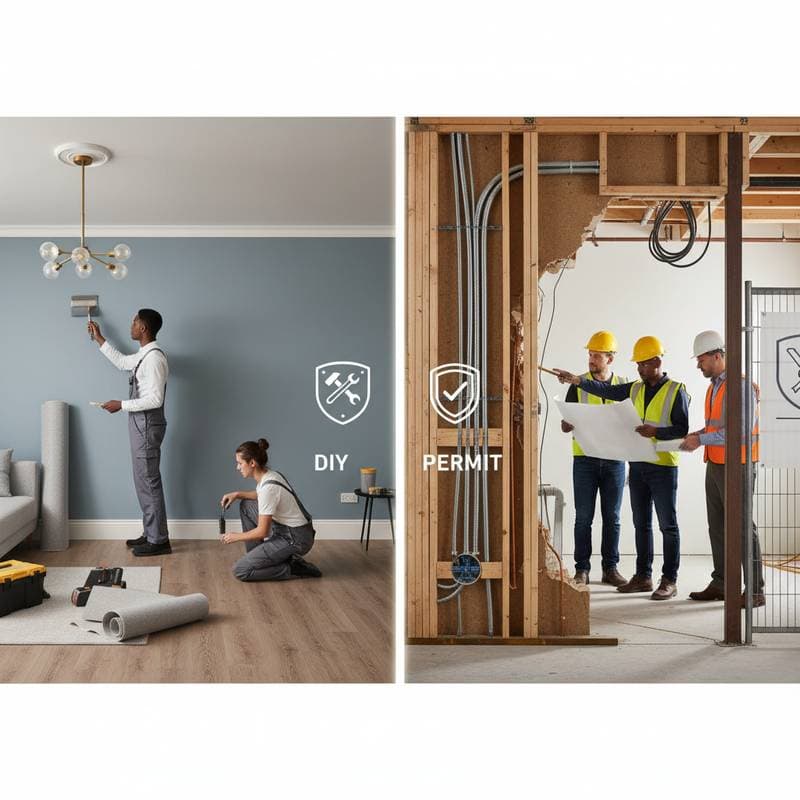What You Can Legally DIY at Home in 2025
Homeowners often experience a surge of enthusiasm when embarking on do-it-yourself projects. This energy fuels transformations that personalize living spaces. However, legal boundaries exist to ensure safety and compliance, and distinguishing between permissible DIY tasks and those requiring permits proves essential.
Identifying the Boundary Between DIY and Permit Requirements
Cosmetic alterations generally qualify as legal DIY endeavors. Tasks such as painting interior walls, installing new flooring like laminate or vinyl planks, adding trim molding, or updating cabinet pulls proceed without the need for permits. These modifications qualify as non-structural because they leave the home's core framework, electrical wiring, and plumbing intact.
Projects that impact structural integrity or critical systems trigger permit requirements. Examples include relocating interior walls, modifying load-bearing beams, installing new electrical circuits, or extending plumbing lines. Local authorities designate these as major alterations to safeguard against hazards like collapses, fires, or floods.
Evaluate each project by considering its potential to compromise safety or property value. Contact your municipal building department for clarification on specific rules, as regulations vary by location.
Everyday DIY Projects That Avoid Permit Needs
Homeowners frequently complete the following tasks without official approval:
- Painting or wallpapering interior surfaces to refresh room aesthetics
- Laying laminate, vinyl, or engineered hardwood flooring over existing subfloors
- Installing or replacing kitchen countertops and bathroom backsplash tiles using adhesive methods
- Constructing low-profile outdoor decks or garden sheds that measure less than four feet in height
- Upgrading light fixtures, faucets, or ceiling fans without altering underlying wiring or pipes
- Adding blown-in or batt insulation to attics and accessible crawl spaces
These initiatives enhance curb appeal and functionality while adhering to legal standards. Fresh paint and modern flooring, for instance, boost marketability during home sales.
Home Improvements That Demand Permits
Certain renovations necessitate permits and often professional oversight:
- Rewiring electrical systems or integrating additional outlets and circuits
- Relocating or installing new plumbing fixtures, such as sinks or water heaters
- Removing or adding walls that support the home's weight distribution
- Replacing roofs or repairing damaged framing in attics or basements
- Setting up central heating, ventilation, or air conditioning units with new duct runs
Regulations stem from the severe risks involved. Improper electrical work might spark fires, while faulty plumbing could cause extensive water damage. Permits verify that work meets current building codes, protecting occupants and the property.
Balancing Safety, Insurance Coverage, and Expert Input
Responsibility accompanies DIY privileges. Proceeding without required permits on regulated projects may void insurance policies in the event of accidents or failures. During property transactions, unpermitted modifications can complicate appraisals and deter buyers.
Collaborate with licensed professionals to maintain oversight without relinquishing all involvement. Delegate complex installations to certified electricians or plumbers while handling preparatory tasks like demolition or painting. This strategy minimizes expenses and guarantees adherence to standards.
Steps to Launch Compliant Home Projects
Consult your local building authority's online resources before initiating work. Search for permit exemption lists tailored to your jurisdiction, and document all inquiries via email or notes for future reference.
Allocate funds for materials, permit applications, and safety gear. Expect fees to start at fifty dollars for minor approvals and escalate based on project scope. Essential equipment includes safety glasses, dust masks, reinforced gloves, and stable scaffolding.
Mastering these guidelines elevates home improvements from uncertain ventures to reliable achievements. Secure compliance preserves structural soundness and financial security, allowing focus on creative outcomes that endure.
